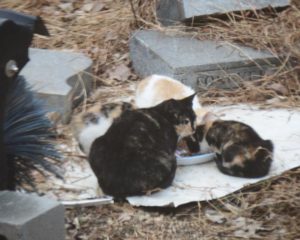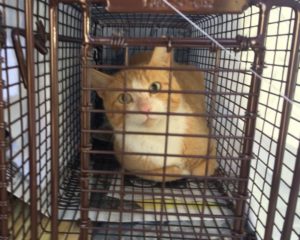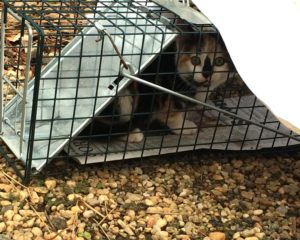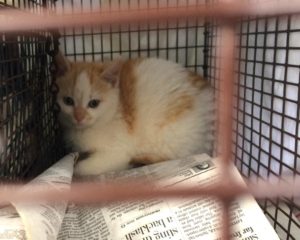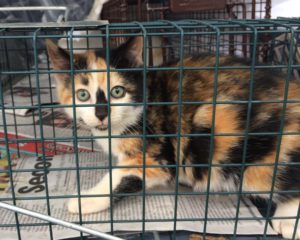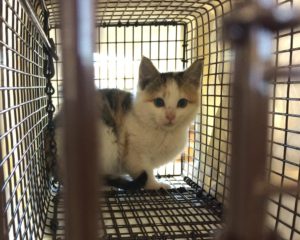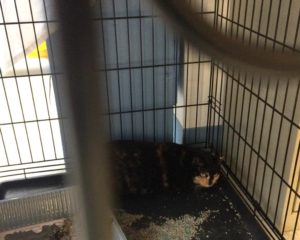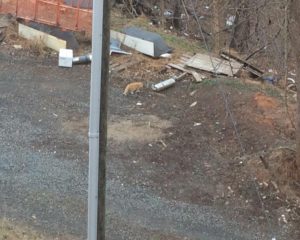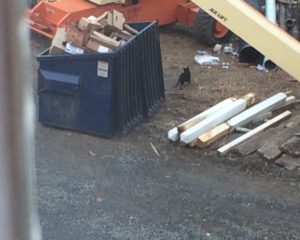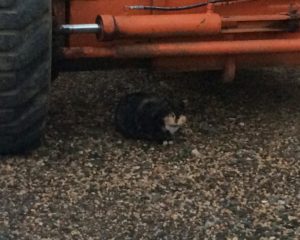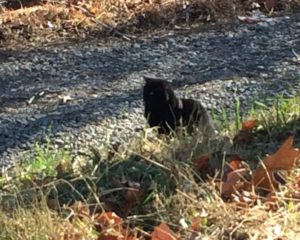In early December 2016, I discovered that a beautiful calico mama cat and her four kittens were living behind the art building at my school. When I saw one of my co-workers setting out a can of food for them, I got in touch with her and we began planning a way to safely trap them.
We started feeding the kitties regularly, and this allowed me to photograph them from my classroom using the telephoto lens on my camera. From what I could tell from my pictures–and by watching them–the kittens looked very healthy. They all were active, playful, and beautiful!
My friend, Kim, has experience with feral cats, and she arranged for me to borrow a number of safe traps from the local chapter of “Voices for Animals.” My co-worker and I continued to feed the kitties as we prepared for “trapping day.”
Early on Wednesday, December 14th, I placed a small amount of canned cat food in the far end of each of 5 traps, and set them out near the feeding area. Within an hour, I could see that two of the traps had closed! I drove my car around to the back of the building and saw that the mama cat was in one of the traps, and an orange and white cat that I hadn’t seen before was in the other trap! Was this unknown cat the father of the kittens?!
I put both of the trapped adults in my car, and after waiting about an hour (hoping to catch some of the kittens), I drove to our local SPCA. A “no kill” shelter, CASPCA offers free spaying and neutering of feral cats, with the understanding that these kitties will be part of the “TNR” program: Trap, Neuter, Return. TNR cats are “fixed,” receive vaccinations, have their left ear “tipped” (to indicate that they’ve been sterilized), and then returned to the area where they were trapped.
Unfortunately, most truly feral adults are simply not adoptable–and there are thousands of wonderful, adoptable cats languishing in shelters because there are not enough adopters…. At least through the TNR program, cats are returned to the area where they were trapped, no longer capable of producing kittens. With regular feeding and simple shelters, TNR ferals usually do well. I got the mama cat and the orange and white kitty to the SPCA early enough on Wednesday for them to have their surgeries that day.
I drove back to school, relieved to have trapped the two adults, and by early afternoon I could see that two more of the traps were closed! YAY! I’d trapped two of the four kittens! I made another trip to the SPCA (after removing the remaining traps from the area to avoid catching a kitty–or something else!–that night), and these beautiful babies were accepted into a foster program. As foster kittens, they’ll be given lots of TLC, spayed/neutered, vaccinated, socialized, and ultimately available for adoption.
At this point I should note that if situations were different, I would have gladly brought all four of the kittens home with me instead of taking them to the SPCA. Yes, I’m a “crazy cat lady.” I got my first kitten, Missy, when I was five years old, and there have been few times in my life when I haven’t had at least one cat….
In 1964 (when the picture below was taken), Missy was primarily inside, though she went outside some during the day. Now, however, all of my cats are inside, exclusively, and I’ve had as many as eight under roof at one time when my sons lived here with their cats!
And a bit more of the back story: On November 14th, exactly one month before trapping these kitties, I lost Kai, one of my four elderly cats. I’d adopted him and two of his siblings from a shelter in 2002, and his death was completely unexpected. It still hurts, but I like to think that my love for ALL cats–including ferals and shelter cats–is part of my beautiful Kai’s legacy….
Sadly, all of my remaining old ones have health issues. It wouldn’t have been good for them to deal with 4 rambunctious, mostly-wild kittens, and it also wouldn’t have been fair to expose the kittens to some of the illnesses that my elderly cats have. I knew this (and still know it), but I have to admit that I had an especially hard time surrendering the little calico baby I’d trapped. I hope she finds a wonderful–truly WONDERFUL–loving home! <3
On Thursday, December 15th, I set out the traps again, feeling somewhat desperate about catching the remaining two kittens. With their mama cat and their siblings gone–and with temperatures forecast to plummet into the low teens that night–I REALLY wanted to trap them!
Just before my second exam period of the day (all of this was happening during exam week at school, by the way!)–I could see that two of the traps were closed. I asked my students to watch from the windows while I drove around to the back of the building. YAY!!! Two kittens!!
I put them in my car, drove around to the front of the building, and my students helped me carry them upstairs to the classroom. (It was already really cold outside, and I didn’t want to leave them in their traps in my car since they couldn’t move around much to keep warm.) We placed them on a table and covered the traps with blankets while the kids took their semester tests. It was a very quiet room, interrupted by the occasional “meow.” 🙂
As soon as the students were done, we carried the traps back to my car and I headed–again–to the SPCA. These two kittens would join their siblings at the foster mom’s house, and I needed to pick up the two adults who’d had their surgeries the day before. I’d paid to board them at the SPCA on Wednesday night, but there was no space available for them to be kept another night. I REALLY didn’t want to release the female that evening since it was supposed to be so cold–but to my surprise, the orange and white cat that I’d assumed was the “baby daddy” was a female, too!
With both cats in the car and no good plan, I called Kim again. She had previously let me borrow a large dog crate (which I’d put in my basement, in case I needed it for the kittens), and she said she had another crate I could borrow. I stopped by and picked that one up (and returned some of the empty V.F.A. traps to her), stopped by the store to buy a couple of disposable litter boxes, and went back to school.
My co-worker came over to my classroom and we put the smaller crate in the far back corner of the room and added a litter box plus bowls with food and water in them. We set the trap with the orange kitty up close to the open crate, used large pieces of cardboard on either side of the trap to make a barricade, put on gloves, and then carefully opened the trap. Success! The orange kitty ran into the crate!
We had to leave the mama cat in the trap while we drove to my house to get the large crate, then we went back to school and used the same method to get her out of the trap and into a crate. Both cats were very, very scared, but I told them (repeatedly) that they were better off hanging out in the crates for a day or two while they healed than being outside in the cold temperatures–especially with their bare, shaved bellies….
This was the first time I’d dealt with feral cats on an up close and personal level, and these girls were so different from my cats and other “domestic” cats that I know…. They were silent, and I don’t think they slept at ALL on Friday when I was in my classroom. They didn’t pace around, they didn’t meow–they just sat there, frozen in place. Only their eyes moved as they warily watched and waited…
My co-worker fed them on Saturday morning. Because we didn’t feel comfortable opening the crates, we devised a way to use a long wooden spoon and a spouted watering can to reach through the bars of the crates to add food and water to their bowls.
When I went to school Saturday afternoon to release them (the weather had gotten much warmer), I discovered that the orange girl had pulled the whole sheet that had covered her crate into her litter box! (Both of these feral cats had used the litter boxes…. Smart kitties!)
I mentioned that I had the crates in the far back corner of my classroom. It is a HUGE room (70 feet from end to end; this picture was taken just after the space was renovated), and I had to figure out how to safely get the kitties from one end to the other and then outside….
I started with the smaller crate that the orange cat was in. I gently put the crate on a blanket and slowly dragged it to the other end of the room, into the hall, and then to the top of the stairs. (I’d already propped open the doors at the bottom of the stairs.) Again using cardboard boxes and large pieces of cardboard as a barricade, I angled the opening of the crate towards the stairs, and (wearing gloves) carefully opened it. She hesitated just for a moment, then quickly made her way down the stairs, out the door, and around to the back of the building. (Oh, see all the trash down in the woods? A bear–yikes!–raided the dumpsters earlier in the week….)
I repeated this drag-and-barricade method with the mama cat’s crate, and she also made a beeline for the back of the building.
As I cleaned up the crates–dumping and washing out the food bowls, throwing away the litter boxes, etc.–I looked out the window again. The mama cat was sitting in the area that we’d been feeding them! Too funny!
After I finished cleaning up, I drove to the back of the building, and the mama cat was still there, waiting to be fed.
She was MUCH closer than she’d been in the days before she was trapped, and her whole demeanor was just … different. Instead of the wary, frozen cat in the crate in the back of my classroom, she was relaxed, confident, and clearly in her element.
At that point, I realized that this little warrior princess mama cat–raider of dumpsters and protector of kittens–was home….
Unlike my cats who are never outside, never cold, never hungry, and usually curled up on a bed or on my lap, these feral cats live in a dangerous world filled with weather extremes and a variety of predators (including foxes, raccoons, hawks–and BEARS!) It’s not always a safe or a comfortable place–and survival is NOT guaranteed–but it is their place, their world, and where they feel at home.
Unfortunately, I’ve become aware of at least two more cats living on our 1600-acre campus, and we’ll continue to try to trap these ferals for TNR. In the meantime, we’ll make sure that they are fed regularly, and while there are *many* places they can go to get out of the weather, I’d like to make at least a couple of feral shelters for them.
As my friend Tonya said, trying to reduce the number of homeless cats and kittens is kind of like trying to bail out a sinking ship with a thimble. True. And our “ship” is obviously still leaking; this is one of the new-to-me ferals I’ve now seen on campus….
So while there’s still much work to be done, I offer my sincere thanks to Kim, Jaime (my co-worker), Voices for Animals, and the wonderful people at CASPCA. Their assistance, advice, and support allowed me to trap a total of 6 cats in two days, have two adult females spayed, and give 4 beautiful kittens a chance to be socialized and adopted into loving homes. It’s a good start. <3


